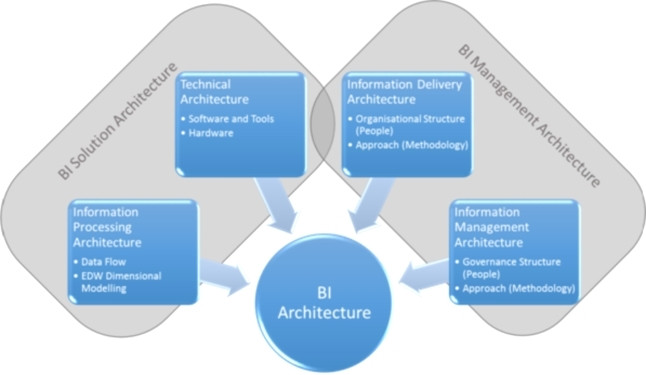"Your visions will become clear only when you can look into your own heart. Who looks outside, dreams; who looks inside, awakes." - CG Jung

My previous Industry Insight ended at the bottom of the BI strategy mountain, but at least having a clear view of the mountainous terrain and environment (having completed the macro-economic and external analysis as per the strategy framework diagram below).
If this is Mount Everest, what is effectively understood is there are two basic routes to the summit: the southeast ridge from Nepal and the north ridge from Tibet (technically more difficult). The problem is that one is still left wondering whether s/he has what it takes to reach the top, and this might just leave one too overwhelmed to consider the journey ahead at all.
Internal analysis
Following the wisdom of CG Jung, it is important to start looking inside to become awakened. With internal analysis, there is a clear view of what capabilities are required to undertake the journey, and then take stock of current capabilities, identifying the gaps and planning to address them.

Starting with the capabilities required, a strong understanding is needed of the key building blocks of a mature BI system. The diagram below provides a framework for all the components that make up a BI system.
Internal analysis essentially entails (1) describing the future ("to-be") view of the BI architecture; and then (2) evaluating the current BI landscape in comparison with the "to-be" picture to identify all the gaps that need to be addressed.
In describing the "to-be" picture, lean on the findings of the external analysis already done. Understand all the capabilities available in each of the BI architecture categories, and then decide which of the industry standard capabilities is required in the company and which is not.
For example, big data is currently a huge hype in the BI industry, but that does not necessarily mean the BI solutions architecture should provide a big data capability. To get business buy-in for a BI strategy, never push a solution in want of a problem. Then again, don't miss an opportunity if the demand is not obvious at first glance. Engage with business in search of opportunities, and it may just prove to be visionary leadership, by incorporating capabilities the company is not currently aware it needs.
Once the "to-be" picture is clear, start by mapping and evaluating the current BI capabilities against the vision. Identify future BI capabilities that do not exist at all, and also BI capabilities that require improvement. Here, a BI maturity model becomes a critical tool.
A BI maturity model can assist with identifying gap areas, especially underlying gaps in existing BI capabilities. A variety of BI maturity models are available globally.
For example, the TDWI EDW maturity model measures the sophistication of the technical architecture, but ignores the information processing architecture as well as the BI management architecture.
Gartner's "Maturity Model for Business Intelligence (BI) and Performance Management (PM)" answers the short-comings of TDWI by incorporating three key measures (people, processes, and technology). However, the model is based on the premise that the primary business value of BI is enabling corporate performance management. Therefore, it doesn't incorporate current trends of big data, advanced analytics, decision optimisation, embedded operational analytics, etc, into the model.
In a similar fashion, all current BI maturity models may measure some architectural areas effectively, but have gaps in others. Therefore, one needs to find the one that best aligns with the BI strategic direction. Another option is to use a selection of maturity models to cover the whole BI architecture landscape; however, these models do have a cost implication.
The conclusion of the internal analysis phase should be a concise list of BI capabilities that either needs to be established from scratch or requires improvement.
Plan strategy execution
All the hard work is done. Now only to formulate the strategic vision and goals statements, formalise strategic objectives and a set of strategic initiatives. The goals and objectives are based on findings of the external and internal analysis. The initiatives are based on activities required in order to address all the gaps identified.
Avoiding an in-depth strategy lecture, here are some guidelines of articulating a strategy statement in a BI context:
Strategic goals (highest level): Always translate each of the key front-end capabilities requested by C-level to a BI strategic goal.
Strategic objectives (second-level detail - describe 'what' the company wants to achieve): List between three and five objectives in each of the BI architecture domains and articulate how each of these supports at least one of the BI strategic goals. Objectives are not a three- or four-word phrase, but rather a short, concise statement.
Strategic initiatives (third level - describe 'how' the company will achieve the objectives): List the high-level initiatives (usually between four and eight initiatives per BI architecture domain) and clearly articulate each initiative's alignment with at least one strategic objective.
With internal analysis, there is a clear view of what capabilities are required to undertake the journey.
Remember, the BI strategy is ultimately intended to be a guide for the journey up to the summit. Therefore, be specific, be direct, use language the company understands (avoid technical buzzwords and acronyms) and be reasonable.
Plot all of the initiatives on a roadmap, with a time-horizon of two to four years. By providing a roadmap, the magnitude (complexity, effort and cost) of the initiatives become more palatable. Standing at the foot of Mount Everest, understanding the terrain and environmental factors to be faced, and after internal analysis, understanding what health, strength and fitness levels will be required... If I'm left thinking that I have to be ready on all fronts tomorrow, I will definitely turn around and go home.
Having clearly articulated strategy, supported by a timeline illustrating the plan of gradually preparing for the climb, and highlighting incremental milestones of improved maturity, one awakens to the possibilities of adventure and victory.
Share